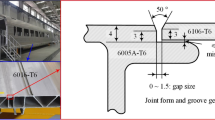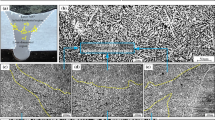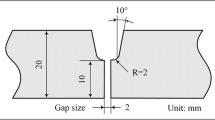Abstract
Three-mm-thick 6106-T6 aluminum alloy extrusions were laser-MIG hybrid–welded with different assembling clearances. The effects of the assembling clearance on the weld formation, microstructure, and mechanical properties were investigated. When the assembling clearance was not larger than 0.7 mm, the optimum welding parameters were universal; the microstructure, microhardness distributions, tensile and fatigue properties were basically similar. To obtain well-formed weld formation, reducing the welding speed was more advantageous than increasing arc current when the assembling clearance enlarged. When the assembling clearances enlarged, the size of cellular dendrites increased and the width of columnar zone reduced; meanwhile, some cracks appeared near the fusion line. The lowest microhardness appeared closest to the fusion line in the heat-affected zone or existed away from the fusion line in the heat-affected zone when the assembling clearance was smaller or larger than 0.7 mm, and the lowest microhardness was reduced and the width of heat-affected zone increased as the assembling clearance enlarged. The average tensile strengths decreased when the assembling clearances enlarged. The tensile specimens fractured closest to the fusion line in the heat-affected zone or away from the fusion line in the heat-affected zone when the assembling clearances were smaller or larger than 0.7 mm, and the fracture features were changed from ductile to ductile-brittle–mixed failure mode. The median fatigue limit and safe fatigue limit were significantly decreased when the assembling clearance was larger than 0.7 mm, the fracture locations of fatigue specimens changed from in the weld zone to closest to the fusion line in the heat-affected zone, and the hot cracks that existed near the fusion line were the main reason.












Similar content being viewed by others
Data availability
The data supporting the conclusions are included in the article.
References
Cornacchia G, Cecchel S, Panvini A (2018) A comparative study of mechanical properties of metal inert gas (MIG)-cold metal transfer (CMT) and fiber laser-MIG hybrid welds for 6005A T6 extruded sheet. Int J Adv Manuf Technol 94:2017–2030
Shibata K, Sakamoto H, Iwase T (2006) Laser-MIG hybird welding of aluminium alloys. Weld World 50:28–34
Zhan X, Zhao Y, Liu Z, Gao Q, Bu H (2018) Microstructure and porosity characteristics of 5A06 aluminum alloy joints using laser-MIG hybrid welding. J Manuf Process 35:437–445
Acherjee B (2018) Hybrid laser arc welding: state-of-art review. Opt Laser Technol 99:60–71
Chen C, Shen Y, Gao M, Zeng X (2020) Influence of welding angle on the weld morphology and porosity in laser-arc hybird welding of AA2219 aluminum alloy. Weld World 64:37–45
Lee CM, Woo WS, Baek JT, Kim EJ (2016) Laser and arc manufacturing processes: a review. Int J Precis Eng Manuf 17:973–985
Wang J, Nishimura H, Fujii K, Katayama S, Mizutani M (2009) Study of improvement of gap tolerance in laser MIG arc hybrid welding of aluminium alloy. Weld Int 23:723–733
Turichin G, Tsibulskiy I, Kuznetsov M, Akhmetov A, Mildebrath M, Hassel T (2015) Influence of the gap width on the geometry of the welded joint in hybrid laser-arc welding. Phys Procedia 78:14–23
Pellone L, Inamke G, Hong KM, Shin YC (2019) Effects of interface gap and shielding gas on the quality of alloy AA6061 fiber laser lap weldings. J Mater Process Technol 268:201–212
Zhang Y, Han S, Cheon J, Na S, Gao X (2017) Effect of joint gap on bead formation in laser butt welding of stainless steel. J Mater Process Technol 249:274–284
Lamas J, Frostevarg J, Kaplan A (2015) Gap bridging for two modes of laser arc hybrid welding. J Mater Process Technol 224:73–79
Sharma A, Mohanty UK, Tanaka M, Suga T (2021) Mechanism of gap bridge ability in lap-fillet laser-arc hybrid welding. Lasers Manuf Mater Process 8:355–371
Jing H, Ye X, Hou X, Qian X, Zhang P, Yu Z, Wu D, Fu K (2021) The influence of laser power and butt gap on the droplet transfer and weld formation of laser arc hybrid welding. J Phys Conf Ser 2002:012009
Huang H, Zhang P, Yan H, Liu Z, Yu Z, Wu D, Shi H, Tian Y (2021) Research on weld formation mechanism of laser-MIG arc hybrid welding with butt gap. Opt Laser Technol 133:106530
Schultz V, Seefeld T, Vollertsen F (2014) Gap bridging ability in laser beam welding of thin aluminum sheets. Phys Procedia 56:545–553
Köhler M, Tóth T, Kreybohm A, Hensel J, Dilger K (2020) Effects of reduced ambient pressure and beam oscillation on gap bridging ability during solid-state laser beam welding. J Manuf Mater Process 4:40
Allen CM, Hilton PA, Blackburn J (2012) Increasing the tolerance to fit-up gap using hybrid laser-arc welding and adaptive control of welding parameters. Proceedings of the 37th International MATADOR Conference, Manchester, England.
Li F, Feng S, Li M, Zhu Y (2018) Softening phenomenon of heat-affected zone in laser welding of 6082 Al alloys with filler wire. Chin J Lasers 45:1102007
Zhang K, He C, Liu D, Yan C, Niu H, Yang Z, Bao Y (2022) Effect of heat input on microstructure and tensile properties of laser welded Ti-3Al-6Mo-2Fe-2Zr alloy joint. J Mater Res Technol 17:1652–1661
Chen Y, Fan C, Lin S, Yang C (2023) Effect of tungsten inert gas welding parameters on hot crack sensitivity of cast magnesium alloy. J Mater Eng Perform 32:1382–1389
David SA, Vitek JM (1989) Correlation between solidification parameters and weld microstructures. Int Mater Rev 34(5):213–245
Kuo T, Lin H (2006) Effects of pulse level of Nd-YAG laser on tensile properties and formability of laser weldments in automotive aluminum alloys. Mater Sci Eng A 416:281–289
Li G, Zhang P, Wu X, Nie Y, Yu Z, Yan H, Lu Q (2018) Gap bridging of 6061 aluminum alloy joints welded by variable-polarity cold metal transfer. J Mater Process Technol 255:927–935
Sepe R, Wiebesiek J, Sonsino CM (2020) Numerical and experimental validation of residual stresses of laser-welded joints and their influence on the fatigue behaviour. Fatigue Fract Eng Mater Struct 43:1126–1141
Funding
This work was supported by the Liaoning Provincial Education Department Scientific Research Foundation of China [grant number JDL2020026].
Author information
Authors and Affiliations
Contributions
All authors contributed to the study conception and design. Material preparation, data collection, and analysis were performed by Zhibin Yang, LingZhi Du, and Xing Wang. The first draft of the manuscript was written by Zhibin Yang and all authors commented on previous versions of the manuscript. All authors read and approved the final manuscript.
Corresponding author
Ethics declarations
Ethics approval
The authors confirm that they have abided by the publication ethics and state that this work is original and has not been used for publication anywhere before.
Consent to participate
The authors are willing to participate in journal promotions and updates.
Consent for publication
The authors grant the publisher the sole and exclusive license of the full copyright in the contribution.
Conflict of interest
The authors declare no competing interests.
Additional information
Publisher’s Note
Springer Nature remains neutral with regard to jurisdictional claims in published maps and institutional affiliations.
Rights and permissions
Springer Nature or its licensor (e.g. a society or other partner) holds exclusive rights to this article under a publishing agreement with the author(s) or other rightsholder(s); author self-archiving of the accepted manuscript version of this article is solely governed by the terms of such publishing agreement and applicable law.
About this article
Cite this article
Yang, Z., Du, L. & Wang, X. Effect of assembling clearance on welding characteristics of laser-MIG hybrid welding for aluminum alloy extrusions. Int J Adv Manuf Technol 129, 3523–3535 (2023). https://doi.org/10.1007/s00170-023-12392-z
Received:
Accepted:
Published:
Issue Date:
DOI: https://doi.org/10.1007/s00170-023-12392-z




